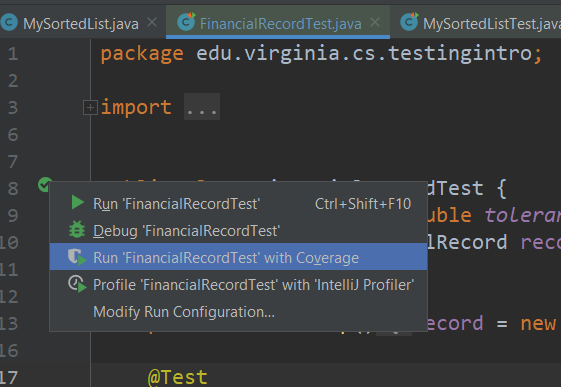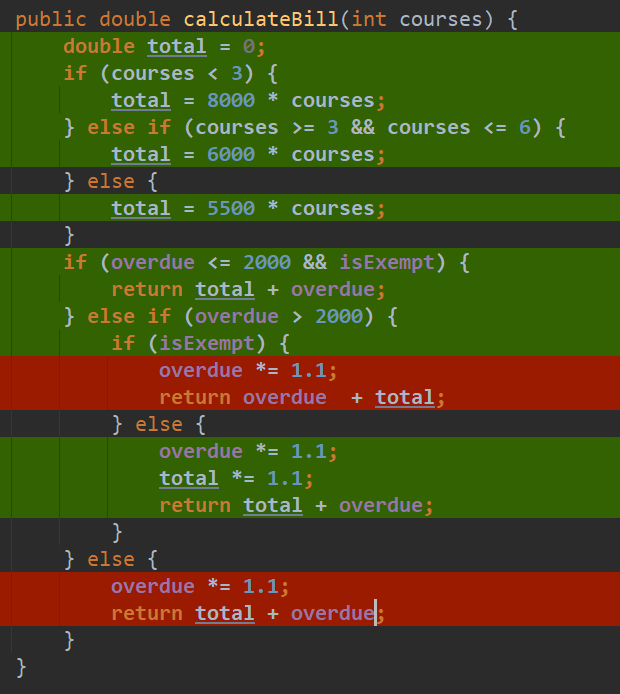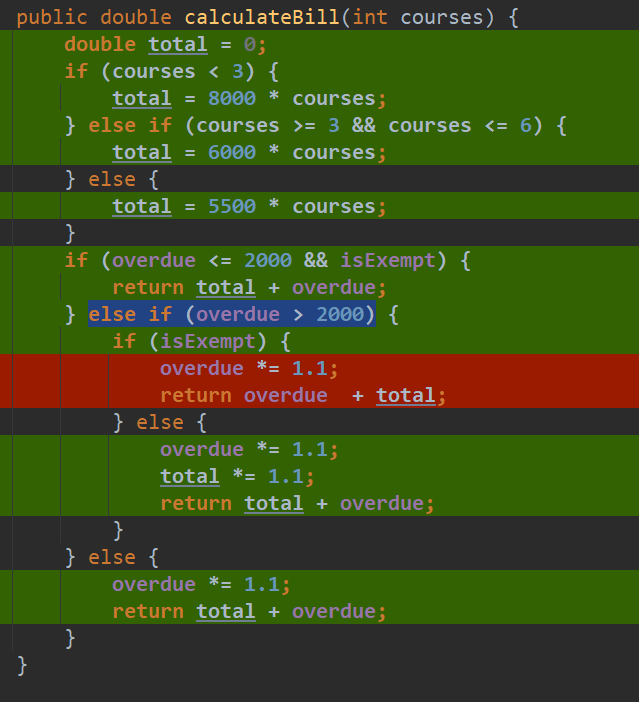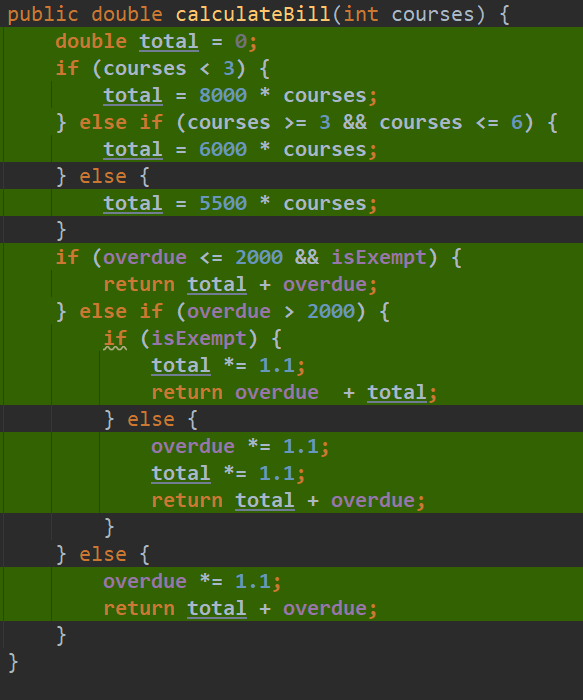White-Box Testing
In this module, we will look at white-box testing (sometimes called “glass-box” or “open-box” testing). We will compare it to black-box testing, and talk about how it can supplement our black-box testing in improving our confidence in code correctness.
The Story so Far
In the last module we used Black-Box testing to select test cases for a function calculateBill.
The specification read:
Follow the specification steps IN ORDER 1) First, calculate total:
- All courses cost the same, and cost per course is determined by the number of courses taken
- $8000/ course if less than 3 course
- $6000/ course if 3-6 course
- $5500/course if greater than 6 courses
2) Increase the value total by 10% if overdue is greater than 2000
3) Increase the value of the field overdue amount by 10% if exempt is false (this is done AFTER step 2) - if exempt is true, this penalty is waived, and overdue does not change.
4) Return the sum of total and overdue
In Black-Box testing, we select what test cases to write based on the specification.
Our tests so far are:
| Test# | exp. return | exp. overdue | act. return | act. overdue | result |
|---|---|---|---|---|---|
| 1 | 20350 | 2750 | 20350 | 2750 | PASS |
| 2 | 31500 | 1500 | 31500 | 1500 | PASS |
| 3 | 51150 | 2750 | 51150 | 2750 | PASS |
And good news, they’re all passing now! However, in our haste to complete the test-writing from the last module, we maybe got a bit sloppy with our TDD practices. That is, we wrote some code that isn’t actually checked by these tests.
Now that we have code that is written, we can use White-Box testing to ensure our existing code is reasonably tested.
White-Box Testing
In White-Box Testing (sometimes called Glass-Box testing), we select cases while considering the existing implementation of the code. This is contrasted with Black-Box Testing, where we select test cases by considering the interface as specified for the method we are testing. As a note, because White-Box Testing relies on writing tests based on existing implementation, we actually cannot use White-Box testing as a starting point in Test-Driven Development. TDD is inherently Black-Box.
Testing with Coverage
When testing existing code, we want to consider code coverage. That is, to what extent is the code tested?
Statement Coverage
Statement coverage is a measure of what percentage of statements have been covered by our tests.
Consider the following pseudocode:
public void myFunc(int a, int b) {
if (a > b && b > 0) {
statement1;
statement2;
}
while(b > 0) {
statement3;
b--;
}
}
If we tested this function with myFunc(3, 1), we could get
100% statement coverage.
100% statement coverage is a good minimum target for testing, as we don’t want to rely on any lines of code we haven’t tested at least once. However, consider all the situations this doesn’t test.
Branch Coverage
For example, what if statement1 sets up an object that statement3 relies on? This means that if statement3 runs without statement1 running, you could get a NullPointerException? Even though our previous test had 100%
statement coverage, it still didn’t consider that possibility?
With branch coverage, we want to write tests such that we test the outcome of all conditional logic. That is:
- for every if-statement, we test with the condition
trueandfalse - for every loop, we test enters loop as well as skips loop. If we’re using a
do-whileloop, we want to test one pass and multiple passes.
So now, using our existing test, we need to add one more to get branch coverage.
myFunc(3, 1)- teststrueandenters loopmyFunc(-2, -1)- testsfalseandskips loop
Conditional Coverage
Similar to branch coverage, but our distinction is that in conditional coverage, for everyone boolean value, we want to evaluate the code if it’s true or false. For example, in the if statement:
if (a > b && b > 0)
When aiming for complete conditional coverage, We don’t just want to consider if the whole statement is true or false, we want at least once test for every possible combination of true or false. For this if-statement, we could do this with 4 tests:
myFunc(3, 1)-trueandtruemyFunc(-2, -1)-falseandfalsemyFunc(-1, -2)-trueandfalsemyFunc(1, 3)-falseandtrue
Note that it may not always be possible to test every combination of true and false. For example, say you had an if statement in a “write a review system” that ensured your rating was on a 1-5 scale:
if (1 <= rating && rating <= 5)
In this case, 100% conditional coverage is impossible, because it’s impossible for both clauses to be false at the same time: no number is both less than 1 and greater than 5.
Path Coverage
Path coverage is a little trickier. Here, we are interested in what percentage of possible paths through our code we have taken. So in the above example, that could be:
- enters
if, enters while loop - skips
if, enters while loop - enters
if, skips while loop - skips both the
ifand thewhileloop
Our two previous test cover the first and last cases, but not the second and third case. As such, in this case, if we want full path coverage, we would need at least 4 tests. Additionally, if you want both 100% path and conditional coverage, the number of tests can expand exponentially.
Path coverage, however, can explode in complexity, especially if you have a lot of nested logic or loops.
Back to our example
Back to the calculateBill() function, let’s check the statement coverage of our tests on our solution. We can do this in IntelliJ by using “Run with Coverage” on our tests:

From there, we can see the coverage by opening the code
for our calculateBill function:

Note that I have changed my local settings in IntelliJ to highlight the lines in order to make the results more readable. By default, the coverage color only appears next to the line number on the left.
Here, we can see the lines our tests have executed. Green lines mean a line that has been executed by a passing test. Red lines mean the line has not been executed by a test. So we can see two pairs of lines that have not been executed by our tests:
- the lines after
if(isExempt)inside of theelifblock - the last two lines of the function inside the
elseblock
This means our solution from the black-box and TDD unit have untested code! Let’s fix that.
Test 4
We already have our existing tests:
| Test# | exp. return | exp. overdue | act. return | act. overdue | result |
|---|---|---|---|---|---|
| 1 | 20350 | 2750 | 20350 | 2750 | PASS |
| 2 | 31500 | 1500 | 31500 | 1500 | PASS |
| 3 | 51150 | 2750 | 51150 | 2750 | PASS |
Now let’s write test 4. For this, we are going to try to reach the last two lines of the function inside of the else block:
else {
overdue *= 1.1;
return total + overdue;
}
First, we need to ask “What inputs lets us reach this line”. Working backwards, it tells us that both of these if-statements must be false:
if (overdue <= 2000 && isExempt)else if (overdue > 2000)
Starting with the second condition, we know overdue must be <= 2000. Otherwise we would enter the else-if. Then, by the first condition, since overdue <= 2000 must be true, we can assume that isExempt must be false for us to enter the else statement at the end of the function.
So, our test input must have overdue <= 2000, and isExempt = false. The number of courses doesn’t matter, so let’s pick 5. Thus, we get Test 4:
| Test# | courseCount | overdue | isExempt | exp. return | exp. overdue |
|---|---|---|---|---|---|
| 4 | 5 | 1500 | false | 31650 | 1650 |
We calculated the expected values by handing using the specification. We then write this test as a JUnit:
@Test
public void testCalculateBill_MidCourse_SmallOverdue_NoExempt() {
record.setOverdue(1500);
record.setExempt(false);
assertEquals(31650, record.calculateBill(5), tolerance);
assertEquals(1650, record.getOverdue(), tolerance);
}
Now, we re-run all of our tests with coverage and:

Our test is passing and we have successfully tested our targeted lines! Now, let’s write a test to get the last two red lines.
Test 5
To reach this line, we need the following conditions:
if (overdue <= 2000 && isExempt)must be falseelse if (overdue > 2000)must be trueif (isExempt)must be true.
So, we need to test with a large overdue value with exempt true. So we design test 5, calculating expected values by hand:
| Test# | courseCount | overdue | isExempt | exp. return | exp. overdue |
|---|---|---|---|---|---|
| 5 | 5 | 2500 | true | 35500 | 2500 |
Then write the test in JUnit:
@Test
public void testCalculateBill_MidCourse_SmallOverdue_NoExempt() {
record.setOverdue(2500);
record.setExempt(true);
assertEquals(35500, record.calculateBill(5), tolerance);
assertEquals(2500, record.getOverdue(), tolerance);
}
And now we run our tests, and it fails!
expected: <35500.0> but was: <32750.0>
Expected :35500.0
Actual :32750.0
We found a defect! As we look at our code and the specification, we notice that we made a mistake! In the condition where overdue is larger than 2000, we should increase the value of total by 10%. However, because isExempt is true, the value of overdue should not increase! Yet our code reads:
} else if (overdue > 2000) {
if (isExempt) {
overdue *= 1.1;
return overdue + total;
}
We multiplied the wrong value by 1.1! We apply our fix:
} else if (overdue > 2000) {
if (isExempt) {
total *= 1.1;
return overdue + total;
}
And run our tests, and now Test 5 passes! And now we have full statement coverage!

Getting to 100% coverage
It may seem that getting to 100% path and conditional coverage is unrealistic; and in some cases, it can be mathematically impossible. However, part of the problem is that our functions may be more complicated than they need to be.
In fact, this function is too complicated, which hurts its testability. In our Code Quality unit, we will revisit this function and re-write it to simplify its testability.
White-Box vs Black-Box
Understand that white-box and black-box do not tell us how we are testing. are strategies that tell us what tests to write! The tests themselves are structurally the same. We simply used both techniques to select the inputs of our test.